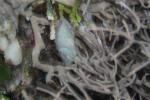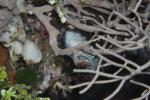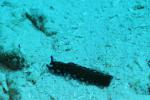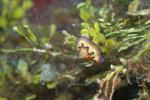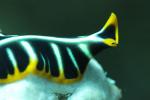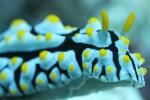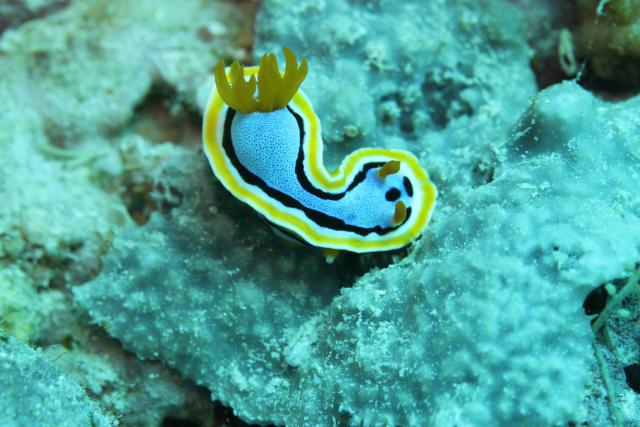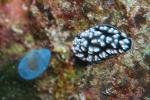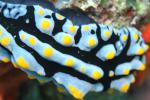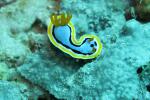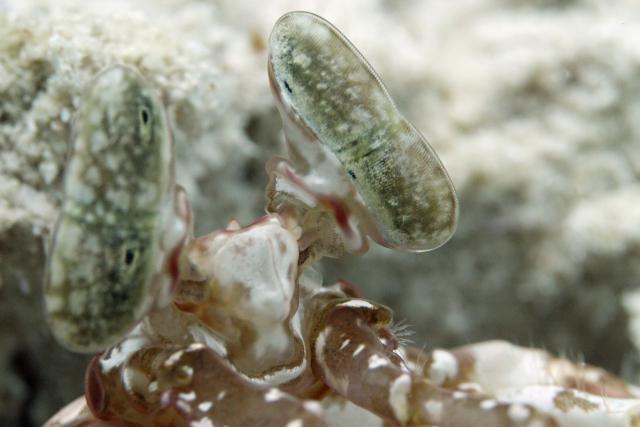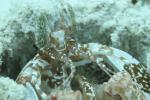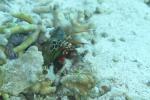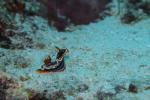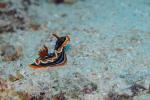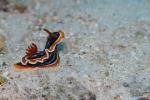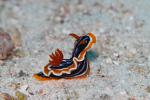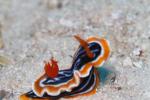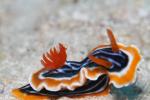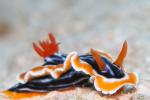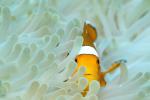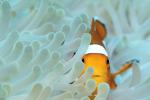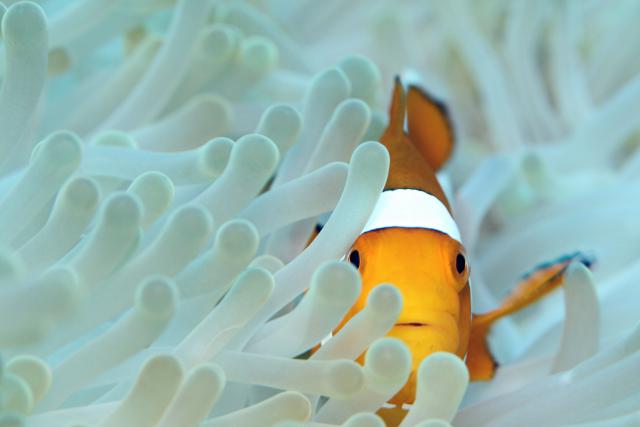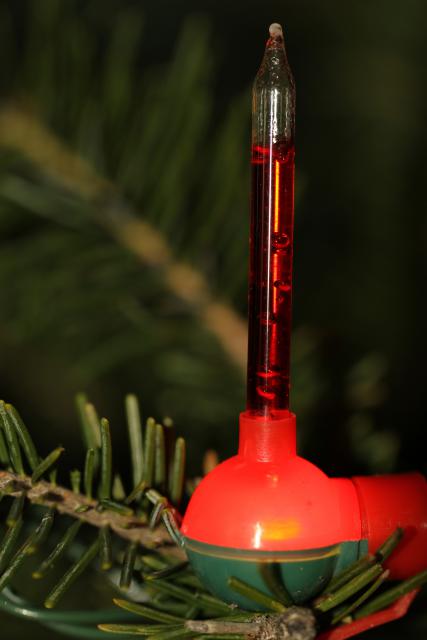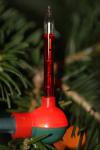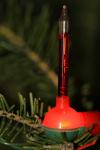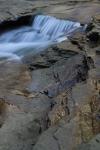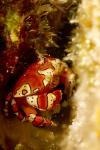flash
Wakatobi: Fire Dartfish
ktuli — Wed, 03/23/2011 - 20:59
Alright, back to the dive photography (how I wish that meant back to taking dive photos!) to try and get back into my routine of regular posts.
Today's little guy (or girl - can tell for certain what sex it is) is a Fire Dartfish (Nemateleotris magnifica). They are small (about three inches max) and very skittish, so getting close to fill this much of the frame with one is a bit of a challenge.
Technical Data: Canon EOS 7D, Canon EF 100mm f/2.8L Macro IS USM, 1/130th sec at f/8. Image Stabilization on. ISO 800 (Auto). Ikelite Housing and Port with Ikelite 161 Strobe in TTL Mode. Auto-smartfix and brightness reduced 10% in Photoshop Elements 8.0
What Works: The best part of this photo for me is how the fish jumps off the screen - there is just a three dimensionality to the shot that really pops! The colors of the dartfish are spot on, and the depth of field provides a nice soft background with just enough detail to show some of the liverock in the background.
What Doesn't Work: First, the dartfish itself is a bit washed out - those bright white scales are just so easily over-exposed. Additionally, the positioning of the fish in the frame is less than ideal with it looking out of the frame.
What do you think? Drop me a comment and let me know.
- Bill
Wakatobi: Cuttlefish!
ktuli — Sun, 02/27/2011 - 20:17
So one of the things that I really wanted to see while in Wakatobi was a cephalopod. So far on our two previous dive trips to Cozumel, we'd gotten close but my poor air consumption caused us to miss out. The first year, we were sitting on the boat for a good while before the rest of the group surfaced with stories of seeing multiple octopi. Last summer, the group all swarmed a small coral mound where an octopus was spotted, but my air was low and strong currents literally pulled Anya and I away from the opportunity.
For this trip, I was bound and determined to see some sort of cephalopod - an octopus, a squid, or possibly even a cuttlefish (I wasn't going to push my luck and expect to see a nautilus). The brochure for Wakatobi made it seem like we would see any (or all - except for the nautilus) of these critters on a majority of the dives.
The week started out semi-promising. The folks at the front of our group happened upon an octopus while it was feeding on a crab. Unfortunately for us, we were at the back of the group and he got scared off before we could get there. I saw a fleeting glimpse of something, but couldn't be certain of what I saw.
Then things went cold. Everyone in the group (including Mike - our instructor - who has more dives than anyone (including the dive-masters) and as seen just about everything) kept asking the dive-masters over and over for octopi or cuttlefish. The dive-masters subsequently gave us more and more desperate answers as to why we haven't seen them or that they aren't quite as common as we might have expected.
And then came our night dive - which I knew would be my best chance. I decided I wasn't surfacing until I saw something good - something really good. And I didn't care if that meant I had to swim from person to person in the group and steal air from their secondary regulator (interestingly enough called an octopus regulator) until I did.
Early in the dive, the group split into two; myself, Anya, Ferris, Bruce, and Vanessa went off in one direction, while the others went somewhere else (I still don't know how we got split up, or where they went). And things started out pretty promising as we saw a frogfish and a squat lobster (more on both of those at a later date). While both of those things are both cool, they're not cephalopods...
Then Vanessa started making quite the racket to get our attention - it is customary while diving to simply tap on your air tank (usually with something else metal) to make noise to get other divers' attentions. We quickly made our way over to where she was, and were rewarded with seeing this little guy...
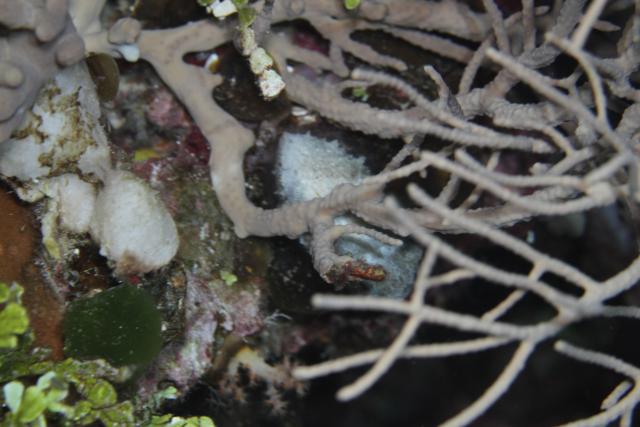
Technical Data: Canon EOS 7D, Canon EF 100mm f/2.8L Macro IS USM, 1/12th sec at f/8. Image Stabilization on. ISO 400 (Auto). Ikelite Housing and Port with Ikelite DS161 Strobe in TTL Mode. No post production.
Honestly, it took me a few seconds to realize what I was looking at - both out of sheer excitement and a bit of confusion from the strong camouflage. In the middle of both of those photos, there is a small white-ish cuttlefish. I apologize for the terrible photos - they're the best I got. It was dark, my pulse was racing, and I wanted to get some shots fired before it disappeared - which it did... only 7 seconds after we found it!
In the first shot, you can see the cuttlefish more exposed through the coral, but camera movement caused a terrible amount of ghosting. You can make out the main body and the large round eyes on the head, and the short tentacles curled up in front of the face. On the second shot, things are a bit more crisp (though still somewhat blurred) and shows a bit more of the skin texture (cuttlefish are able to change their skin texture at will for camouflage), but is more hidden behind the coral.
I'm not 100% sure, but the species might be a Crinoid Cuttlefish (Sepia sp. 2) or a baby Broadclub Cuttlefish (Sepia latimanus). The Crinoid species only get to about 2 inches full grown, whereas the Broadclub - the more common for this area - can grow to 20 inches. Either way - crinoid or baby - this little guy was quite the find! Certainly something fairly rare to see. And obviously, fairly hard to photograph.
Regardless, a mere seven seconds that I will remember for the rest of my life. I might not have captured the best photos with my camera, but I certainly recorded the image in my brain! Which is something that you need to remember to do as a photographer. Sometimes it is the photo that got away that we remember the best and means the most to us. Especially when it drives us to get out there and try for another...
... which I hope I get to do sooner rather than later.
- Bill
Wakatobi: Nudibranch & Flatworm Super Assortment
ktuli — Wed, 02/23/2011 - 21:07
As I said before, one of my favorite critters from Wakatobi were the nudibranchs and flatworms.
In rough terms, they both fall under what most people would call sea slugs. The main difference between the two are that nudibranchs have antennae called rhinophores and most have external gills, whereas flatworms do not have the rhinophores (though some like the Tiger Flatworm and Linda's Flatworm below adjust their head shape to fake them) nor any external gills.
Regardless, they're cool little things... take a look (mouseover the thumbnail for the larger view)
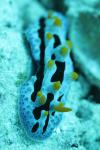 |
Sky Blue Phyllidia (Phyllidia coelestis) |
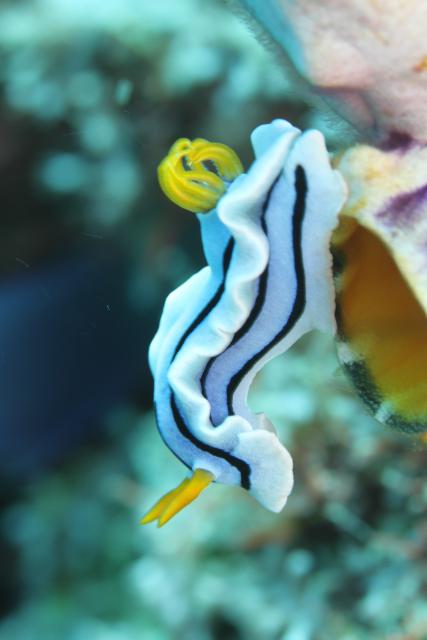 |
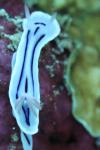 |
Willan's Chromodoris (Chromodoris willani) |
|
 |
Elisabeth's Chromodoris (Chromdoris elisabethina) |
|
 |
Racing Stripe Flatworm (Pseudoceros bifurcus) |
In reality, these are pretty tame looking nudibranchs, so I'm looking forward to another trip back to find more! I think if my count is correct, I photographed thirty-five different individuals (in nineteen dives!) consisting of four different species of flatworms and fifteen different species of nudibranchs.
So cool!
- Bill
Wakatobi: Blue Ribbon Eel
ktuli — Sat, 02/19/2011 - 09:30
As I mentioned yesterday, Roma was one of my favorite dive sites the entire week. Within 15 minutes of hitting the water, our diver masters had found us a Blue Ribbon Eel (Rhinomuraena quaesita), and the Tiger Mantis Shrimp I showed you yesterday.
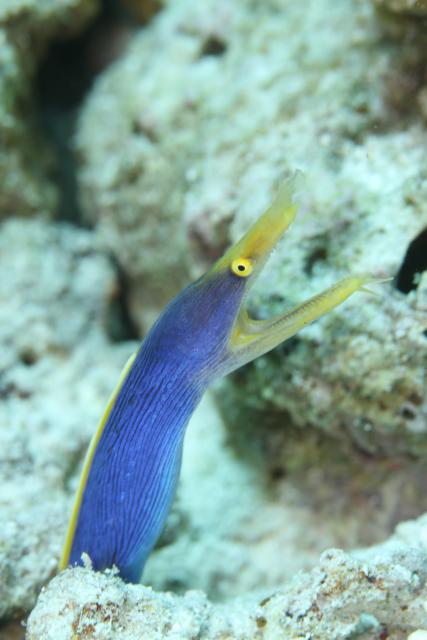 The Ribbon Eel was another critter on my wishlist, and since the brochure for Wakatobi "advertised" that we would see them, it was very nice to not be disappointed. In fact, reviewing the brochure now that we're home, we realize that we saw a majority of what was presented there.
The Ribbon Eel was another critter on my wishlist, and since the brochure for Wakatobi "advertised" that we would see them, it was very nice to not be disappointed. In fact, reviewing the brochure now that we're home, we realize that we saw a majority of what was presented there.
Technical Data: Canon EOS 7D, Canon EF 100mm f/2.8L Macro IS USM, 1/260th sec at f/8. Image Stabilization on. ISO 320 (Auto). Ikelite Housing and Port with Ikelite DS161 Strobe in TTL Mode. No post production.
Why This Photo: Well, let's see... I got certified to scuba dive, saved up for over a year, spent a bunch more for the camera equipment, traveled half-way around the world, all to get to see some of the wonderful creatures I'd only ever seen in nature documentaries and books. I guess I took this photo just 'cause I could.
What Works: The vertical format works well with this subject, and the diagonal line he produces through the shot provides a nice balance. Focus is tack sharp right on the eel's face, and its tiny razor sharp teeth are easily visible. The relatively shallow depth of field produces a softly defocused background to keep the eel as the main subject with minimal distraction.
What Doesn't Work: The black patch on the rock to the right of the eel is a bit distracting, a tighter crop would work better here. Also, the vantage point is still slightly above the eel, a lower vantage point would produce a more intimate image, and perhaps could have made the eel more comfortable with my presence (though I wasn't the only diver sticking a camera in its face!).
Of course, Mike, one of our dive instructors says he's been on dives and seen fields and fields of ribbon eels, but this guy was the first I've seen in person, so he is the coolest ribbon eel I've ever seen.
- Bill
Wakatobi: Mantis Shrimp
ktuli — Wed, 02/16/2011 - 20:18
What you see here are a pair of the most complex eyes known to man.
Technical Data: Canon EOS 7D, Canon EF 100mm f/2.8L Macro IS USM, 1/170th sec at f/8. Image Stabilization on. ISO 2500 (Auto). Ikelite Housing and Port with No Flash. Removed Color Cast and Auto-Smartfix in Photoshop Elements 8.0.
They belong to a Tiger Mantis Shrimp (Lysiosquillina maculata).
Mantis Shrimp (not related to either Praying Mantis nor Shrimp) were something I had on my checklist of things I wanted to see on this dive trip. And much like the nudibranchs, I was not expecting how often we would see them. I personally saw three individuals, plus evidence of at least two more, and others in the group saw several more individuals. This individual was seen at my personal favorite dive site at Wakatobi - Roma, which was also were my False Clownfish photo came from, and we also saw a Blue Ribbon Eel, a Leaf Scorpion Fish, Nudibranchs, Spine-cheek Anemonefish, Fire Dartfish, and tons more (but you'll have to stop back for those photos). If someone told me I could go back to Wakatobi and dive only one site the whole week, it would probably be Roma that I'd pick.
Anyway, you might be asking why those eyes are the most complex known to man. If you're not, you read that article I linked up there, and actually understood it all (I certainly didn't!). But the short story is this: they can see a much wider spectrum of light from us (spanning from infra-red all the way into the ultra-violet spectrum!), meaning they can see about ten times the number of colors we can, they can see and filter linear polarized light (we need sunglasses or camera lens filters for that), and some species can even see circular polarized light (also a job for lens filters), and additionally they do not lose depth perception when using only one eye (humans need both eyes for depth perception). Oh yeah, and they rotate independently, stick out from the head (ie: can see around corners), and if my research is correct, can pick up satellite television. Ok, maybe not that last bit, but they're still pretty impressive eyes. Then again, perhaps it isn't as much of an exaggeration after all - an article on Wired.com discusses how the Mantis Shrimp's eyes are being researched to help develop the next new High-Def recording medium (and I haven't even started switching to Blu-ray, and they're obsolete!).
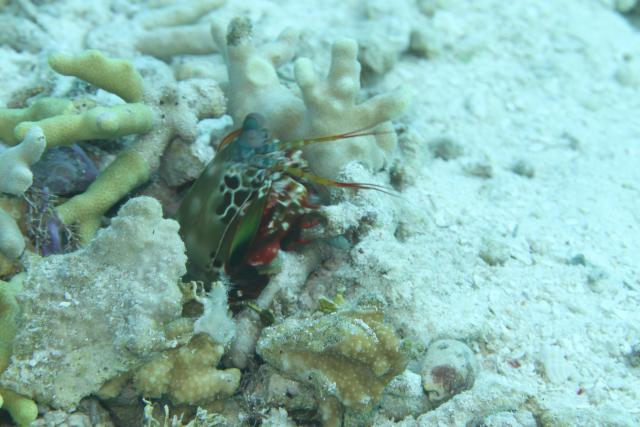
The last guy there is a Peacock Mantis Shrimp (Odontodactylus scyllarus) and is probably considered the more common mantis shrimp. They are sometimes available in the pet trade (and sometimes come into a tank as an unexpected hitchhiker on coral or live rock). They are much more colorful, thus their names.
In fact, I get to take credit for finding that guy on that particular dive (which was at a site called 'The Zoo'). I saw his burrow from about twenty feet away, and quickly made my way there. As I got close, I thought I had seen something duck inside, so I glanced into the hole (literally just a hole in the ground that drops about a foot deep, then branches off to the side) but didn't see anything. So I settled in on the sand and waited and watched. After a few minutes, Brigette (one of our dive instructors) came over and tapped me on the shoulder - which made me jump (I will explain why shortly). She asked what I was looking at, and I tried to explain that I wasn't quite sure if there was anything there or not. But she settled in next to me to wait too. No more than a few seconds later, the Peacock Mantis Shrimp returned to the top of his burrow and did some housekeeping, throwing a piece of broken coral out. I fired off a few frames. I was thrilled, but running low on air, so I passed the camera off to Anya and tried to indicate to her what I had been watching and to get some photos. I must have done a terrible job of explaining what it was, because she said she went over and was looking right down the burrow and trying to figure out what she was supposed to take photos of. Perhaps it was good that she didn't see the Mantis Shrimp, because he probably wouldn't have been thrilled with her getting so close to his burrow.

So why did I jump when Brigette tapped me on the shoulder? Well, as I lay there on the sand staring at this empty hole in the ground, the thought was occurring to me that perhaps the reason it was empty was because the occupant wasn't home. Peacock Mantis Shrimp are roaming hunters, and when they're out of their burrows, they look like the guy to the right (kind of alien, huh?) (Sorry, I did not take that photo - all of the mantis shrimp I saw were in their burrows.)
Still wondering why I might jump? Ok, let me add that some mantis shrimp can grow to 18 inches long! Still not convinced? Let's throw in their hunting styles. There are two styles of mantis shrimp, smashers and spearers. Smashers obviously, as the name implies, simply smash their prey to death; whereas spearers resemble praying mantids more in that they have back-folding raptorial arms they use to impale and hold prey. Still holding out on me, thinking I am a bit too jumpy? How about if I tell you that their attacks have the speed of a .22 caliber bullet - plus are supposed to be able to cause cavitation (causing a voided space in the water, which is then filled, causing a shockwave impact). Having owned a pet store for several years, mantis shrimp were referred to as 'thumb smashers' (I never carried them in my store, but often saw them at distributors). In general, they're nasty little guys. They have the strength to break crab shells, fingers, aquarium glass, and even camera housing lens ports!
Even with all of that, they're still fascinating creatures, and I was thrilled to get to see two different species of them in the wild in their environment, and to bring back photos of both. I look forward to getting even better shots next time!
- Bill
Wakatobi: House Reef Assortment
ktuli — Tue, 02/15/2011 - 19:44
Ok - I'll skip all the blabbering today. Instead I'll just give a nice little assortment of some of the absolutely incredible stuff we got to see just stepping off the beach and diving on Wakatobi's house reef.

Banded Sea Snake (Laticauda colubrina)
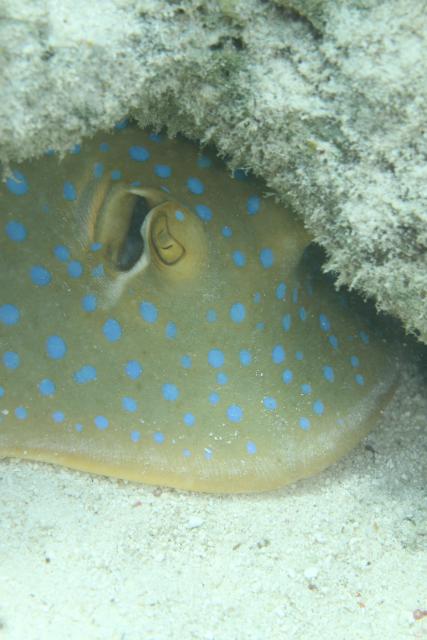
Blue-Spotted Ribbontail Ray (Taeniura lymma)

Crocodile Flathead (Cymbacephalus beauforti)
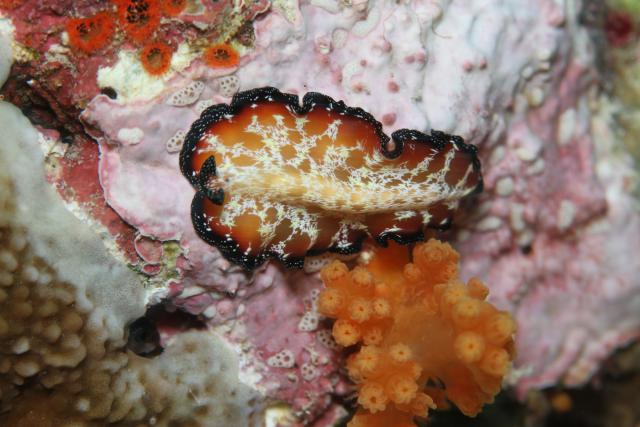
Lightning Flatworm (Pseudobiceros fulgor)
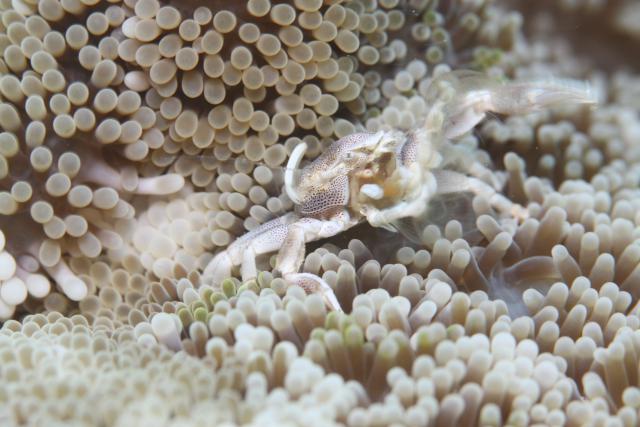
Spiny Porcelain Crab (Neopetrolisthes spinatus)

Twinspot (sometimes also Fu Manchu in the pet trade) Lionfish (Dendrochirus biocellatus)
I wish we had had another week that we could have spent just diving the house reef over and over. Perhaps next time!
- Bill
Wakatobi: Magnificent Chromodoris Nudibranch
ktuli — Sat, 02/12/2011 - 22:16
Today we'll start looking at one of my favorite subjects from the Wakatobi trip - nudibranchs and flatworms. I knew ahead of time that we would see some, but I was not prepared for how many. If my count is accurate, we saw around 35 different individuals (plus some more that we saw and weren't able to photograph) consisting of up to 15 different species of nudibranchs and 4 species of flatworms.
This little guy is a Magnificent Chromodoris (Chromodoris magnifica). C. magnifica can grow to about three and a half inches long, and are carnivores that feed on sponges. But really, they are just beautiful to look at.
At this point in the week, I had figured out some of my problems working with the strobe, and combined with the 8 frames per second burst rate on the 7D, I began to try a new technique for photographing subjects. I would make as slow and controlled of an approach as I possibly could, taking photos the entire way. Doing so would help to control my buoyancy (holding perfectly still in the water is still a bit difficult for me), and thus increase my number of keepers.
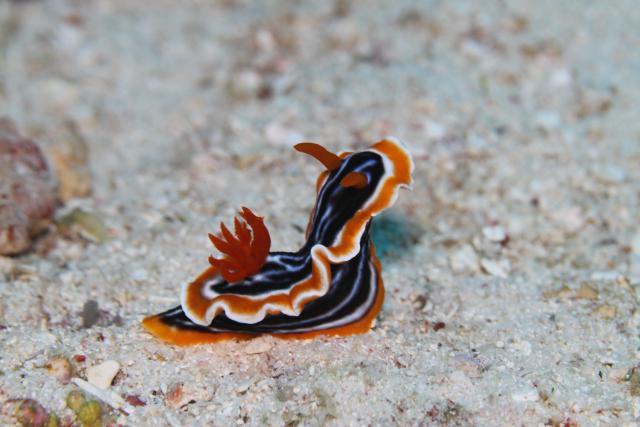
Technical Data: Canon EOS 7D, Canon EF 100mm f/2.8L Macro IS USM, 1/25th, 1/32nd, 1/40th, 1/32nd, 1/25th, 1/16th, 1/5th, 1/10th sec respectively at f/8. Image Stabilization on. ISO 400 (Auto). Ikelite Housing and Port with Ikelite DS161 Strobe in TTL Mode. No post production.
If you mouseover the thumbnails, the larger images will display; progressing through the set will show a bit more of the technique I was describing. There are a couple interesting things to note in the series...
First, you can notice that the earlier shots have a bluish cast to them (since they are unmodified). This is due to the amount of water the light has to travel to make the photo. Even with a strobe such as the Ikelite DS161, any increased distance from a subject will result in a bluish cast. The series makes it very apparent how that color cast goes away as you get closer to your subject and shorten the distance that the light has to travel.
Also, if you look at the second to last shot in the series (the closest one, second from right on bottom) you can see a slight amount of ghosting. The comes from the slow shutter speed of 1/6th of a second and the camera (and me along with it) moving during the exposure. I threw away the shots that were worse, but you can still see it slightly here. This may have been remedied had the camera selected a higher ISO, but that was not the case.
Finally, the last photo being further away from the subject is not a mistake in my ordering them here - that is actually how it was shot. I would also shoot as I backed away from a subject. To do so, I would either place a finger or two on the rock or substrate and push back (you never want to touch coral or most other living surfaces on a reef - both to prevent damage to the reef as well as to avoid injury, remember that most reef creatures have stinging cells called nematacyst) or simply inhale semi-deeply. The second technique is rather interesting and is very effective on slower approaches with no overhanging reef above me. While diving, even changing the volume of air within your lungs can change your buoyancy in the water (and since you're doing that constantly by breathing, it is apparent why it isn't exactly simple for everyone), and I have learned that if I take a slightly larger than normal breathe and hold it for a few seconds, I will slow rise in the water. As I rise, I then exhale to restore my buoyancy to the desired level (and to avoid pulmonary barotrauma).
I know that the majority of folks reading this probably won't benefit from the combination of photography and scuba technique suggestions, but if you ever do decide to try underwater photography, it is worth keeping in mind... ;)
I promise to share more nudibranch and flatworm shots as they were among my favorite subjects for the week. For now, thanks for stopping by, and I hope you enjoyed this magnificent little creature (yes, pun intended!)
- Bill
PS: If you haven't checked out the False Clownfish poll post from the the other day, please do so and cast your vote! If you did already check it out, swing on back as I updated with a photo of the cake the Wakatobi staff presented to me as a 'prize' for that photo!
Poll: Wakatobi: False Clownfish
ktuli — Tue, 02/08/2011 - 21:22
First off, my apologies for the delay in getting to these posts. After getting home from the trip, I realized I had taken over 6600 exposures (mostly due to the camera being set to high speed burst mode). I spent time removing any photos that we're up to par or just duplicates due to the high speed bursts, and trimmed the set down to around 1750. I meant to go through posting photos from the trip in a chronological order, but I know some folks are waiting for this one, so we'll bounce around a little here to start.
The photo was taken towards the end of the week at the Roma dive site. All week long, I'd been enjoying taking photos of the various anemonefish, and this particular set of False Clownfish (Amphiprion ocellaris) provided a nice opportunity for several great shots.
This one, however, was selected by our dive-masters as the "Photo of the Week" for our week. I was absolutely flabbergasted by that announcement. My underwater photography improved by leaps and bounds each dive during this trip, but I still consider that luck was a very (very) large factor in what I came back with. In the coming posts, we'll discuss some of the ways in which the underwater photography improved.
As I said, I was running the camera in high speed burst mode (providing up to 8 frames per second with my Canon EOS 7D) which helped with my luck in capturing the fleeting moments that occur with the constant movement of the subjects, but I distinctly remember seeing this shot develop in the viewfinder and knowing then that I had captured something nice.
When the shot was presented by our dive-masters at the dinner slideshow, it was slightly modified, so I attempted to duplicate those modifications as best I could here. Mouseover each thumbnail below to see the different versions, then place your vote below to let me know which version you prefer (leave a comment with details as to why you selected what you did if you like).
|
|
|
Technical Data: Canon EOS 7D, Canon EF 100mm f/2.8L Macro IS USM, 1/40th sec at f/8. Image Stabilization on. ISO 400 (Auto). Ikelite Housing and Port with Ikelite 161 Strobe in TTL Mode. Modified version cropped and auto-smartfix in Photoshop Elements 8.0
The modifications are very subtle (as I usually feel any post production modifications should be). Initially, the shot was cropped specifically to make the the fish rest right on the intersection of two of the thirds. Then I ran the shot through Photoshop Elements 8.0's Auto-Smart-Fix to adjust some colors (producing a bit more bluish tint to the anemone and darkening the orange of the False Clownfish).
I know I've mentioned before that I should start selling prints, but I haven't gotten setup to do that yet, even with some requests for this photo specifically. So for now, enjoy it for free if you'd like. Here are the links to the fullsize versions - Original and Modified - for use for printing or as a wallpaper (be sure to resize first, or use the smaller version above).
Thanks for stopping by today, and be sure to visit back frequently over the coming days/weeks as I will be continuing all the updates from the trip. And don't forget to place your vote below, and leave a comment as to why you voted as you did.
- Bill
PS: Alastair, enjoy the photo, perhaps we'll meet again underwater some day in the future. Best of luck getting certified!
 PPS: As a 'prize' for the 'Photo of the Week', the fantastic staff at Wakatobi presented me with a fabulous cake made up to be a coral reef. The cake was absolutely fantastic and I shared it with our entire group! The pink stuff on the right is some strawberry roll which was my favorite dessert of the week, and the staff were attentive enough to notice that and give me one of the leftover pieces as additional 'prize'! If anyone from Wakatobi is reading this, thanks again for a most memorable week!
PPS: As a 'prize' for the 'Photo of the Week', the fantastic staff at Wakatobi presented me with a fabulous cake made up to be a coral reef. The cake was absolutely fantastic and I shared it with our entire group! The pink stuff on the right is some strawberry roll which was my favorite dessert of the week, and the staff were attentive enough to notice that and give me one of the leftover pieces as additional 'prize'! If anyone from Wakatobi is reading this, thanks again for a most memorable week!
Indonesia: Sneak Peek (part 2)
ktuli — Sat, 01/29/2011 - 03:05
Wow! Just wow!
So far, we have 12 dives in on this trip, and I've been getting more and more fantastic shots. I've been learning how to better use my gear, as well as how to just dive better (ie: better buoyancy control, better air comsumption, etc), but more on all of that later.
We've seen things we've never seen before, and stuff we've only ever seen in books. I have a very small selection to share today, including: some anemone fish, shrimp, crocodile fish, and sea stars. I've also got a good collection of nudibranch shots going, but I'm going to be stingy with those until I get home... ;)
Enjoy these for now:
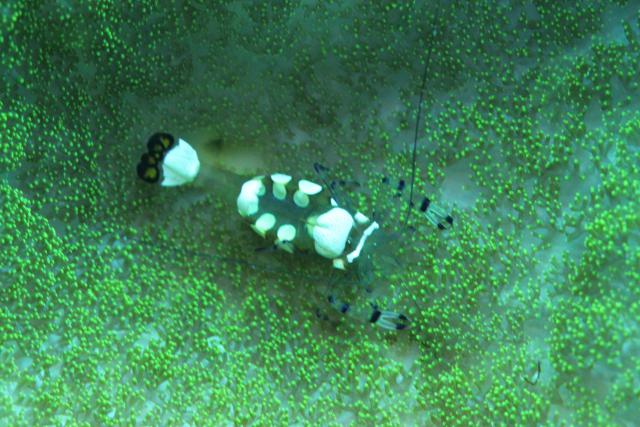
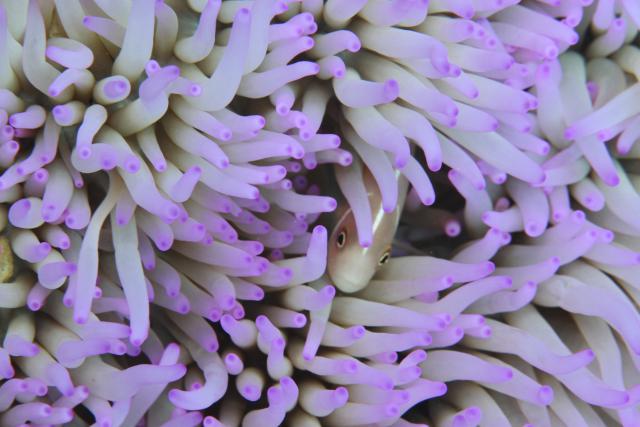
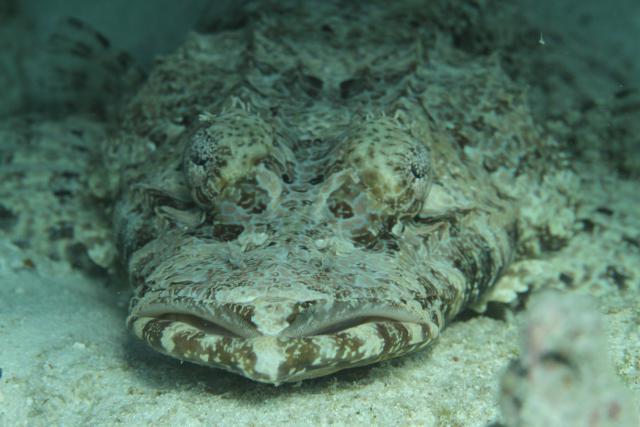
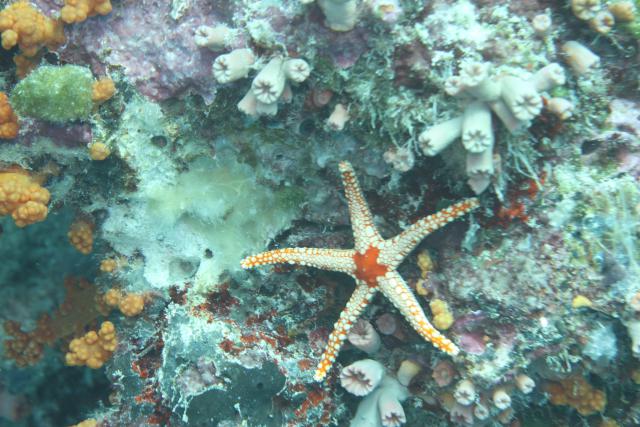
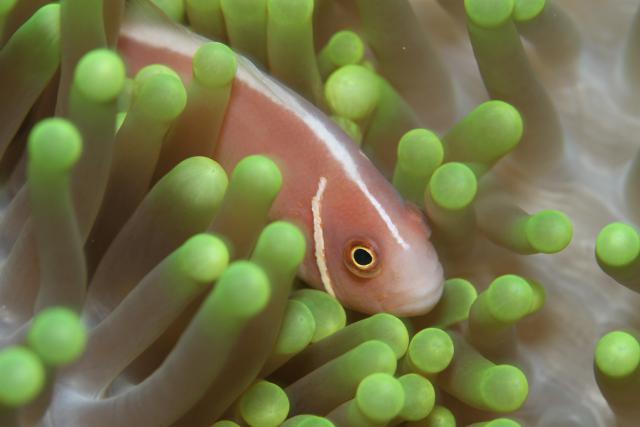
Our afternoon alarm just went off, so we now have to go head out for our second twilight dive!
- Bill
Canon EF 100mm f/2.8L Macro IS USM (part 1)
ktuli — Wed, 12/22/2010 - 21:57
This won't be a comprehensive review by any means, but I figured I would try and get a little something pulled together. Plus I have been thinking about trying this photo for a little while now (basically since we decorated our Christmas tree this year).
 This is my newest lens - the Canon EF 100mm f/2.8L Macro IS USM. Like a previous lens review, let's go through quickly what the letters mean...
This is my newest lens - the Canon EF 100mm f/2.8L Macro IS USM. Like a previous lens review, let's go through quickly what the letters mean...
EF - Stands for Electro Focus, and you can read more here
100mm - This is the focal length obviously, this will fit nicely between my Tamron 180mm and Tokina 35mm macro lenses
f/2.8 - The maximum aperture - at 2.8, this is considered pretty "fast" glass due to the amount of light such a large aperture will allow into the camera, producing faster shutter speeds
L - I've heard multiple definitions for this single letter - the top runners are probably "low dispersion" and "luxury". Canon used to have a page dedicated to the line, but I can't seem to find it. Regardless, this is Canon's professional grade line of lenses. Identified by the red ring at the end of the lens barrel.
Macro - Many lenses get the "macro" label slapped on them, but unless they produce 1:1 magnification, I don't consider them true macro lenses (some people say 1:2 is close enough). What this means is that at 1:1 magnification, the subject is recorded at life-size on the image sensor.
IS - Image Stabilization, we'll discuss that a tiny bit more further down.
USM - Ultra Sonic Motor. This is the auto-focus motor and produces a much faster focusing, while staying almost completely silent. The other nice feature of a USM lens is that it allows for full time manual focusing - meaning you can make manual focusing adjustments even while in auto-focus mode.
I've had this lens on my wishlist for quite some time, and I finally pulled the trigger on it to use with photographing all of the macro life on the reefs in Wakatobi. So I pretended that these bubbler Christmas lights were some small reef invert and went about shooting. I also wanted to get a shot of these lights with the bubbles frozen in motion.
|
|
|
|
|
|
I know that's a fairly random set of changes, and none of them get into too much detail of showing the abilities of this lens. The clarity is very nice on every one of those shots - a testament to the quality glass used, but you only notice that on the fullsize versions.
The IS and non-IS versions are surprisingly not that far off (middle and bottom thumbnails on the right). This is probably due to some patient hand-holding techniques. Usually I'm happy if I can get 1/8th of a second with a handheld shot, and those are at 1/3rd! So perhaps I'll have to try that exercise again sometime.
I ended up using the pop-up flash and faster shutter speeds on several of these shots to help get those bubbles frozen in motion (instead of the blur from the longer shutter speeds), and really wish I could have diffused the light from the flash better to prevent that harsh glare on the glass of the light.
I promise I'll do a more thorough review of this lens in the future (probably not until after the dive trip though), but for now, I'm highly impressed with this lens.
Stay tuned as I have some more Christmas themed photos coming up to close out the week and get us into the holiday!
- Bill


